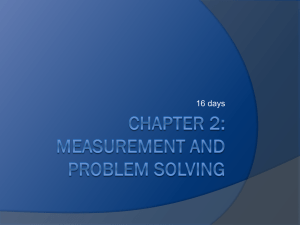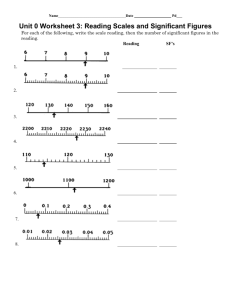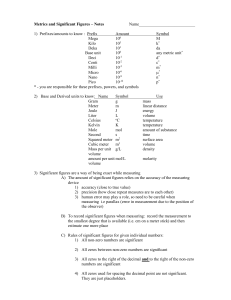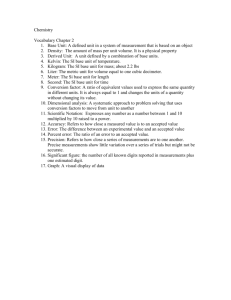km/h --> m/s
advertisement
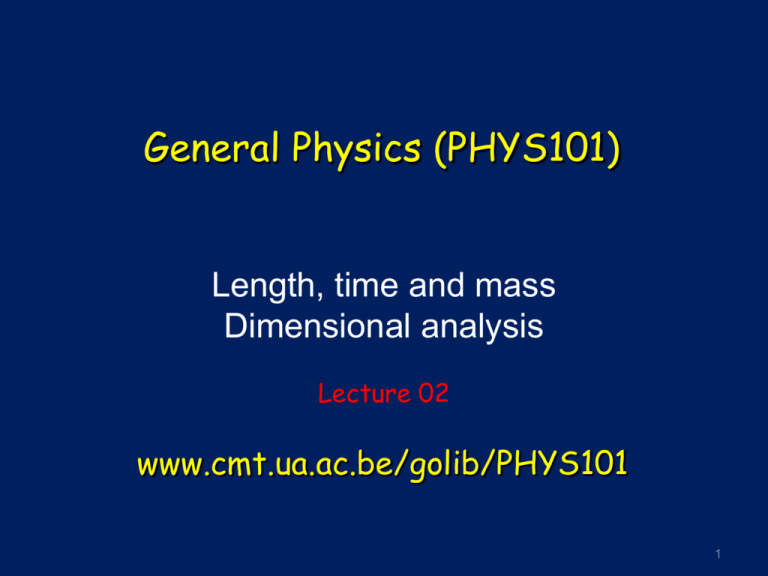
General Physics (PHYS101) Length, time and mass Dimensional analysis Lecture 02 www.cmt.ua.ac.be/golib/PHYS101 1 International System (SI) of Units • • • • Length Time Mass Basic SI Units meter seconds kilogram m s kg These are the only units necessary to describe any quantity. • [Volume] = m3 cubic meter • [Density] = kg/m3 kilogram per cubic meter • [Speed] = m/s meter per second • [Acceleration] = m/s2 meter per second squared • [Force]: N (Newton) = kg m/s2 • [Frequency]: Hz (Hertz) = s-1 • [Pressure]: Pa (Pascal) = N/m2 • [Energy]: J (Joule) = N m • [Power]: W (Watt) = J/s Conversion of Units: Chain-link method Example 1: Express 3 min in seconds? 1min = 60 s Conversion Factor? 3 Conversion of Units Example 3: Express 200 km/h in miles/s? 1 km = 0.6 miles 1h = 60 min = 60 x 60 s = 3600 s 200 km/h= 200 x 0.6 miles/3600 s = 0.03 miles/s Example 4: Express 200 km/h in m/s? 1 km = 1000 m 1 h = 3600 s 200 km/h= 200 x 1000 m/3600 s = 55.56 m/s km/h --> m/s :3.6 m/s --> km/h x3.6 4 Scientific notations Scientific notation Expanded form 1 x 100 1 1 x 101 10 1 x 102 100 1 x 103 1000 1x 106 1 000 000 1x 10-1 1/10 or 0.1 1 x 10-3 1/1000 or 0.001 1 x 10-6 0. 000 001 1.23 = 1.23 x 100 0.25 = 2.5 x 10-1 0.0007925 = 7.925 x 10-4 The following prefixes indicate multiples of a unit. Multiplier Prefix Symbol 1012 tera T 109 giga G 106 mega M 103 kilo k 10-3 milli m 10-6 micro 10-9 nano n 10-12 pico p 10-15 femto f 5 Rounding Speed of light: c=299 792 458 m/s c=2.99 792 458 x 108 m/s • Overestimation: digits 5 to 9 can be dropped from the decimal place during the rounding, however, one should be added to the digit in front of it. • Underestimation: the following digits can just be dropped from the decimal place: 0, 1, 2, 3, an 4. Example 1. Round c to a nearest 1000th. c=2.998 x 108 m/s. Example 2. Round c to a nearest 10th. c=3.0 x 108 m/s. Example 3. Round 273.587 to a nearest integer. 274 Example 4. Round 273.587 to 2 significant figures. 270 6 Uncertainties in measurements • The accuracy of the measurements are determined by significant figures. 7 Rules for Significant Figures 1. All nonzero figures are significant 359 87678 1245 987889 2. All zeros between nonzeros are significant 205 1003 508009 800009002 3. Zeros at the end are significant if there is a decimal point before them 4.200 1003.5600 30.003000 4. All other zeros are non-significant 30000 0.0000344 8 Rules for Significant Figures Not significant Not significant Significant zero at the beginning zero used only to locate the decimal point all zeros between nonzero numbers 0.004004500 Significant Significant all nonzeros zeros at the end of integers a number to the right of the decimal point Just take care of zeros 9 Operations with Significant Figures • When adding or subtracting, round the results to the smallest number of decimal places of any term in the sum 10 Operations with Significant Figures • When multiplying or dividing, round the result to the same accuracy as the least accurate measurements (i.e. the smallest number of the significant figures) Example: Calculate the surface area of a plate with dimensions 4.5 cm by 7.32 cm. A=4.5 cm x 7.32 cm=32.94 cm2. A=33 cm2. 1.0:9 = 0.11111… = 0.1 1.0:9.0 = 0.11111… = 0.11 11 Definition of kilogram Length [L] m Time [T] s Mass [M] kg • Unit for mass is defined in terms of kilogram, based on a specific Pt-Ir cylinder kept at the International Bureau of Standards. Why is it hidden under two glass domes? • Another definition is based on the mass of carbon atom. 12 Definition of second • Defined in terms of the oscillation of radiation from a cesium atom (9 192 631 700 times frequency of light emitted). • US time standard NIST-F1: accurate to 1 second in 80 million years. 13 Definition of meter • Meter is the distance travelled by light in a vacuum during a given time (1/299 792 458 s). • The speed of light is: c=299 792 458 m/s 14 Dimensional analysis: Equation analysis • Complicated formulas can be checked for consistency by looking at the units (dimensions) to make sure that both sides of the equation match. Example 1: Is the equation correct? Example 2: Show that the expression dimensionally correct, where and represent velocities, is acceleration, and is a time interval. 15 Dimensional analysis: Equation analysis Example 3: Is the equation correct? [𝑣] = 𝐿 𝑇 𝑣 = 𝑠𝑡 [st] = 𝐿𝑇 𝐿 ≠ 𝐿𝑇 𝑇 Equation is not correct! Example 4: The volume of a sphere: V= 4 𝜋𝑅2 3 [V] = 𝐿3 [R] = 𝐿2 L3≠ 𝐿2 Equation is not correct! 16 Dimensional analysis: Predictions Example. Use dimensional analysis to determine how the time of a falling apple t depends on the height h. h 17 Summary • Scientific notations • Order of magnitude: 10x (x=1,2,3 ..) • Rounding 18 Summary • Uncertainties in the measurements • Significant figures • It is important to control the number of digits or significant figures in the measurements. 19 Summary • Dimensional analysis is a technique to check the correctness of an equation • Dimensional analysis can be useful in making predictions. 20 21 22


